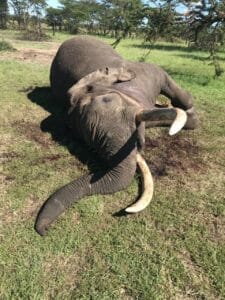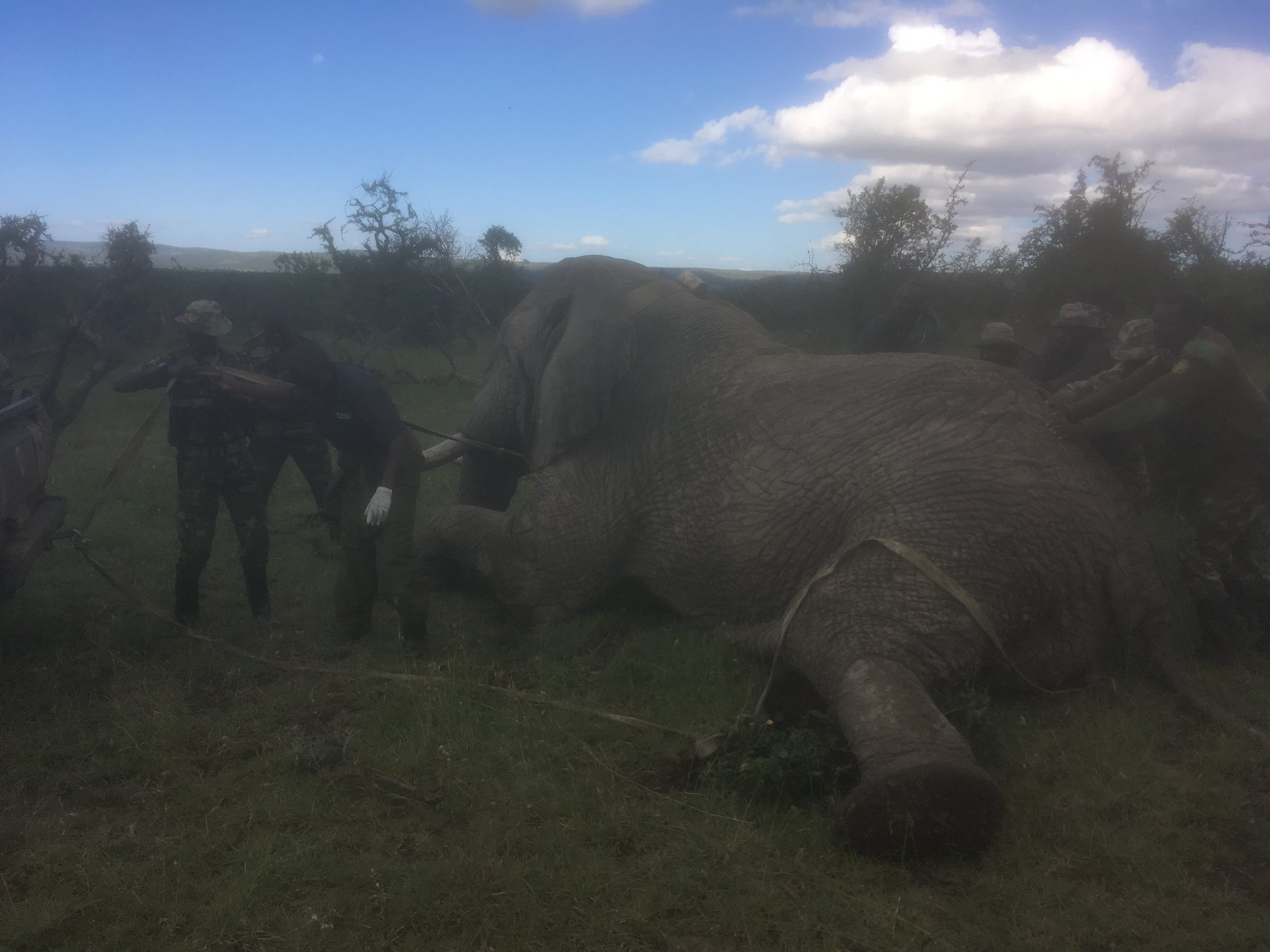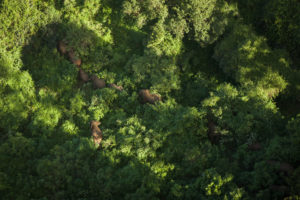It’s been a busy second quarter for Mara Elephant Project with several notable arrests by rangers, a new collared elephant, continued successful partnerships, increased fundraising and a few new hires and internships that have increased MEP’s capacity.

Flying the Karen Blixen Camp Ree Park Safari helicopter monitoring collared elephant Julia.

We should begin with the devastating news that on April 10, one of MEP’s large collared bull elephants Mytene (pictured left) was poached on the border of the Serengeti. The cause of death was spearing and because of MEP’s immobility alert on the Save The Elephants (STE) Tracking System, the Tanzania National Parks Authority (TANAPA) was able to respond quickly and recover the tusks from the large bull; each tusk weighed in at 40 kg. One theory is that MEP’s collar may have dissuaded the poachers from removing his ivory. Mytene was not a crop raider and spent all of his time inside the Serengeti with his girlfriends as one of the last iconic mating bull elephants. This is a huge loss for the Mara-Serengeti ecosystem.
In late May, we also found a poaching attempt on another one of our large collared elephants, Limo. This bull had been shot presumably by poachers but luckily through our monitoring program, MEP rangers were able to spot the wound and Kenya Wildlife Service vet Dr. Limo and the David Sheldrick Wildlife Trust Mara Mobile Vet Unit was able to successfully treat his namesake. The age of the wound was less than 10 days old which helped the MEP rapid response unit trace Limo’s tracks on the Save The Elephants tracking app back to a farm that had been raided by elephants. While they were investigating the attack, the community exposed a suspect for attacking Limo and his herd. He was arrested and taken to Kenya Wildlife Service (KWS) HQ in Ewaso Ngiro.

DSWT/KWS vet Dr. Limo treating MEP collared elephant Limo.
These two poaching instances are prime examples of how important technology like the collars and STE app are to successful MEP investigations and operations. We were able to recover tusks from Mytene, inform our partners and track down Limo’s assailant, all because of these important pieces of technology. This leads me into a very exciting announcement for MEP.
In May, Dr. Jake Wall, currently an geospatial science advisor to Save the Elephants, officially accepted the position of Director of Research at MEP starting in January 2019. He will be responsible for: developing and maintaining MEP’s core research strategy; developing research partnerships with other organizations, academics and universities; liaising with key conservation partners such as KWS, Save the Elephants, and other relevant partners on research priorities; and exploring research/conservation funding options. The results of the research will be used to develop reports and position papers to influence and guide management of the ecosystem. All outputs will be shared with MEP’s target audiences and key partners aimed at raising awareness, facilitating more immediate input and action, informing and influencing policy and practice and developing closer working relationships with key partners. Dr. Wall completed his PhD in elephant movement ecology at the University of British Columbia where he studied the desert elephants of Mali and developed new models for elephant range area estimation. He is an architect of Vulcan’s Domain Awareness System (DAS), and developed the Save the Elephants’ tracking system to track elephants in real-time to help protect them against ivory poaching and to study their movement patterns and conservation in the context of the rapid expansion of the human-footprint across Africa. We are all thrilled at MEP to have such a high caliber scientist join our organization.
In addition to expanding our scientific capacity, we are also bringing our administrative needs in house by hiring Stanley Misoka as the new MEP finance officer that will be based at the new MEP office in Nairobi. Stanley is a Certified Public Accountant with experience in accounting, budgeting and grants financial management. He’s previously worked at NGOs Heifer International, Amref Health Africa and the International Fund for Agricultural Development. This is an important next step for our growing organization but we’d be remiss not to mention the excellent job Seiya Limited did for so many years managing MEP’s finances and logistics.
 Additionally, Mr. Ryan Wilkie (pictured left) is interning at MEP from Save The Elephants from April to September. Ryan is working on sections of MEP’s technical report which we plan to publish by the end of this year. His work is being done under the direct of the MEP scientific committee. IN addition, he is working on producing the elephant yearbook of all MEP collared elephants including their movements, home range and some stories about each one. This will also be a great tool for MEP to use with visitors and donors as well as something we can hand out to safari guides who will be able to better educate their guests on the elephant collars. In May, Mr. Nathan Hahn arrived at MEP for two months to start his data collection for his PhD with Colorado State University in George Wittmeyer’s lab. Nathan will be focusing on HEC mitigation characterization and we are happy to have him on board. Nathan partnered with MEP to conduct a number of drone training packages for Tanzania Wildlife Research Institute (TAWIRI) and Tanzania National Parks Authority (TANAPA) while he worked for RESOLVE.
Additionally, Mr. Ryan Wilkie (pictured left) is interning at MEP from Save The Elephants from April to September. Ryan is working on sections of MEP’s technical report which we plan to publish by the end of this year. His work is being done under the direct of the MEP scientific committee. IN addition, he is working on producing the elephant yearbook of all MEP collared elephants including their movements, home range and some stories about each one. This will also be a great tool for MEP to use with visitors and donors as well as something we can hand out to safari guides who will be able to better educate their guests on the elephant collars. In May, Mr. Nathan Hahn arrived at MEP for two months to start his data collection for his PhD with Colorado State University in George Wittmeyer’s lab. Nathan will be focusing on HEC mitigation characterization and we are happy to have him on board. Nathan partnered with MEP to conduct a number of drone training packages for Tanzania Wildlife Research Institute (TAWIRI) and Tanzania National Parks Authority (TANAPA) while he worked for RESOLVE.
The MEP rangers have been extremely busy during this high human-elephant conflict time. In May, Henrik Rasmussen, the managing director of Savannah Tracking, has deployed five collar-activated alarm systems around farms in high conflict areas. These alarm systems are solar powered and trigger to make a loud alarm sound when the VHF beacon in the elephant collar gets near. This not only alarms the elephants to hopefully leave the area but also alerts the community who might be asleep. Henrik along with MEP ranger units will be testing the effectiveness in the Munyas and Lemek areas with known MEP crop raiding collared elephants, Olchoda and Ivy.

A collar alarm fence post installed in Munyas.
Sadly, on June 23, there was an attack on a bar in Esoit. Football fans had filled up the bar when attackers armed with AK-47 assault rifles burst in and opened fire, killing two people. One of the victims fatally shot was 58-year-old KWS ranger, Mr. Samuel Okumu. Mr. Okumu had previously been attached to MEP and we had conducted a number of operations together. He was a hardworking and dedicated ranger and will be sorely missed by the conservation fraternity. All of us at MEP extend our condolences to his family and friends. Fly high Sam.
 MEP collared one new elephant during this reporting period. On June 5, we were very fortunate to find elephants on several occasions in the Loita Forest. The dense foliage (pictured left) makes finding elephants very hard in this area. Large herds of approximately 20 to 40 individuals were coming into openings in the forest and after first sighting them from the air, we moved into position to collar one female elephant in a herd of 40 individuals. The collaring operation was demanding, and the team worked well in the thick forest conditions. “Amare,” the new Loita elephant, has already been showing interesting movements and rarely comes out of the forested area. We have been trying to collar in Loita for some time, so this achievement is exciting! Yet again, the Karen Blixen Camp Ree Park Safari Robinson R44 helicopter continues to impress. This month it was deployed to collar in the Loita Forest. We visited villages for local intelligence around the forest, ferried in ground teams to the collaring site, darted a female and followed her until she went to sleep, and then perched in a tiny clearing while we dropped single team members off at the collaring site. I was extremely impressed by the performance at high altitude and maneuverability in the forest.
MEP collared one new elephant during this reporting period. On June 5, we were very fortunate to find elephants on several occasions in the Loita Forest. The dense foliage (pictured left) makes finding elephants very hard in this area. Large herds of approximately 20 to 40 individuals were coming into openings in the forest and after first sighting them from the air, we moved into position to collar one female elephant in a herd of 40 individuals. The collaring operation was demanding, and the team worked well in the thick forest conditions. “Amare,” the new Loita elephant, has already been showing interesting movements and rarely comes out of the forested area. We have been trying to collar in Loita for some time, so this achievement is exciting! Yet again, the Karen Blixen Camp Ree Park Safari Robinson R44 helicopter continues to impress. This month it was deployed to collar in the Loita Forest. We visited villages for local intelligence around the forest, ferried in ground teams to the collaring site, darted a female and followed her until she went to sleep, and then perched in a tiny clearing while we dropped single team members off at the collaring site. I was extremely impressed by the performance at high altitude and maneuverability in the forest.
Another exciting development happened on June 26 when we received a call from Dr. Limo that a “MEP” collared elephant he did not recognize was visiting the KWS research station in the Maasai Mara National Reserve. We could not identify the elephant and after calling our partners the Singita Grumeti Fund, they confirmed it was indeed Matobo, one of their collared elephants, visiting the Mara from Tanzania.
We have a busy collaring schedule coming up in July and August with Earhart’s collar dropping off in Mosiro in June, we will need to re-collar in her large herd. Additionally, we plan to collar new elephants in the Mau Forest, Mosiro, and Nyekweri Forest. Thank you, as always, for your continued support.


